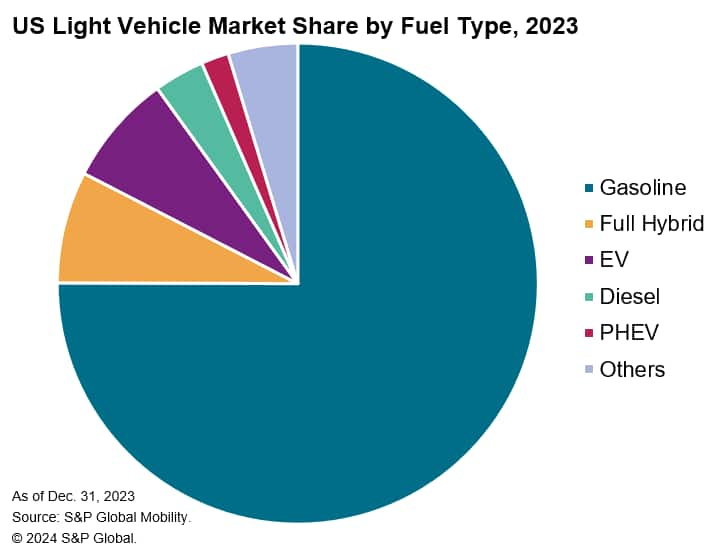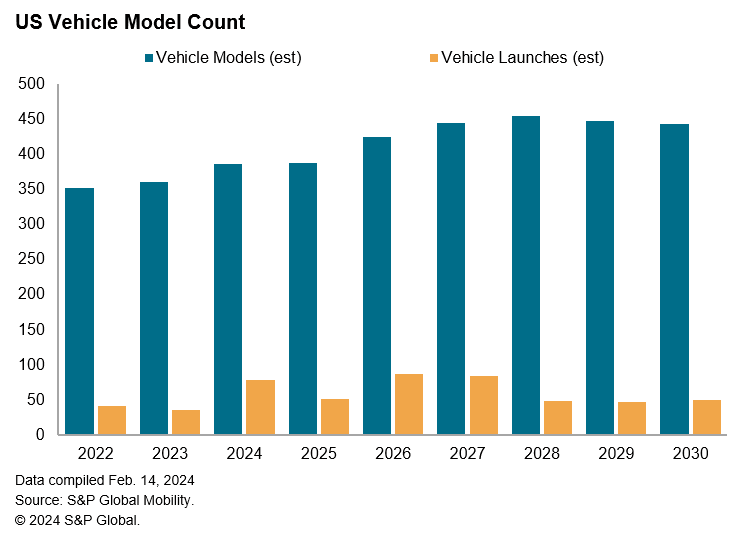Customer Logins
Obtain the data you need to make the most informed decisions by accessing our extensive portfolio of information, analytics, and expertise. Sign in to the product or service center of your choice.
Customer LoginsUS EV sales grew nearly 52% in 2023. So why are automakers slowing EV investments?
Key takeaways:
- Customers are returning to the US market, with 16.5 million vehicle sales expected in 2025.
- EV sales in the US crossed the one-million mark for the first time in 2023, but EV growth is still slower than some automakers and industry observers anticipated
- The challenge for automakers over the next three years will be finding a way to offer a blend of ICE, hybrid, plug-in hybrid or battery electric solutions to meet their consumer needs
- Nearly 80 new product launches are expected in 2024 (both ICE and EV) - more than double 2023 and resulting in about 385 models for US consumers to choose between
- Model choice expected to peak in 2027 with about 445 models
In 2021 and 2022, traditional automakers began accelerating EV programs and increasing planned investment for capacity for vehicle production, but also investing in securing supply of batteries, including in future supply for raw minerals, cathodes and anodes.
In 2023, customers who had been sitting out on the tight inventory, long wait times for many vehicles (electrified and non-electrified) and high mark-ups on some popular models, began coming back to the market. Consumers benefit from better inventory providing more options, but also face higher interest rates and persistently high vehicle prices, in all segments. Many were waiting for traditional, internal combustion engine vehicles, and EV share growth has been perceived as subdued. Still, EV sales in 2023 crossed the one-million-unit mark for the first time and increased about 52% compared with 2022. EV market share in the US reached 7.50%. We are also seeing several automakers increase hybrid availability and doing so with more compelling hybrid positioning for consumers than in the past. The result of those efforts is that registrations of full-hybrid vehicles in the US reached 7.53% and 1.152 million units, slightly ahead of EV market share.
This is also the highest volume of hybrid registrations the US market has witnessed − and hybrid vehicles of many types have been available for more than 25 years. Among the differences between hybrid, EV and plug-in hybrid EV sales is that it is still true that most hybrid and PHEV options are offered in existing nameplates, alongside ICE options, while most new EV models are also new nameplates and expand model count. There are exceptions, as Toyota is offering an increasing number of its vehicles with hybrid-only powertrain choices, while Hyundai offers ICE and EV versions of Kona and Kia offers hybrid, PHEV and EV versions of the Niro. Currently, automakers offering PHEV models also have a companion ICE or hybrid versions in the same model line, and that affects the dynamic for winning customers and for converting electrification skeptics.

All of this means that consumers have more choice than ever, and that automakers with the most flexibility should be better positioned for success over the next few years. Being flexible may not necessarily mean offering every single option, but for traditional automakers, being able to match consumer preference today is as critical as setting themselves up for the future. Pure electric automakers do not need to shift to offering some kind of hybrid, but their potential could be capped by the complexity of the industry in the short term.
EV growth slowing
Despite that there is clear demand for EVs in the US, the rate of EV growth was slower than some automakers had anticipated, for a number of reasons, and it caused several to adjust timing of near-term investment plans. While those making changes are not wavering on their commitment to electrification and leading a shift to battery-electric vehicles, key programs and production capacity investments are being delayed, in some cases from 12 to 18 months.
In the end, these delays may be a smart adjustment; though potentially expensive from an image and capital expenditures strategic perspective, as being in market at the right time to capture consumers' willingness to shift is likely more important than being early. Allocating capital expenditures across a longer timeframe reduces the need for immediate cash, potentially enabling some of that investment to occur with more favorable interest rates for manufacturers as well. Slowing the development of vehicles and production capacity in 2024 and 2025 can reduce risk of having more inventory than the market wants, while being ready for presumed developing demand the last years of this decade. It might also allow for further battery technology developments and supply chain development, which may help bring down battery costs. Battery costs are the key limiting factor on pricing and profitability. On the other hand, the manufacturing delay also means that return on already invested capital is delayed, as well as the fact that plants may be underutilized or sit unused for longer than expected, and that can be costly as well.
There is every expectation that BEV volume and share will continue to grow. However, consumer behavior in 2023 suggests that the pace of growth from 2024 through at least 2026 may be slower than once expected. S&P Global Mobility has been advising for several years that the 2024-2026 time period will be hyper-competitive as the number of new EVs would outpace near-term demand growth. Even as some projects are being slowed, the environment will remain challenging. It is a chicken-and-egg situation, in some ways. Manufacturers and the supply chain can't develop the technology, platforms and manufacturing footprint to support an EV transition overnight. But arriving with volume ahead of demand is costly, both in terms of low utilization and the potential for losing momentum in a brand or model just as the market finally heats up. Though there are exceptions here and there, the US light-vehicle market typically rewards fresh products and penalizes aging products with stabilizing or slowing sales.
Increasing model count creates intensely competitive market
Understanding that changes are happening at a rapid pace, S&P Global Mobility forecasts are changing frequently during this period, and our sales-based powertrain forecast, which reveals electrification and powertrain share, is currently being updated. Our January 2024 light vehicle sales forecast, however, projects nearly 80 new product launches in 2024, both ICE and EV. This compares with only 36 launches in 2023. In 2025, this is forecast to slip to about 50, before picking up again in 2026 to nearly 90 product launches. The increased activity is a result of automakers updating ICE products in key segments as well as introducing segment-complementary EV products.
This activity is expected to also increase the number of overall models available to consumers in the US market from 357 in 2021 to 386 in 2024, expected to peak in 2027 at about 445 models, though beginning to pull back after that. Beyond 2027, we expect to see the beginning of ICE projects ended for some; several luxury brands have committed to shifting to an all-EV lineup between 2026 and 2030. This situation is also highly fluid and in recent weeks at least one luxury automaker now says that meeting previous EV share targets is not going to happen as soon as they projected and has recommitted to maintaining ICE options longer. Other brands are reconsidering the number of EVs planned through the end of the decade as well as reconsidering what segments they will participate in. However, to meet projections, ICE nameplates will be dropped. For mainstream brands, the dual ICE-EV lineups will persist in several segments into the next decade, though some rationalization of their product lines is expected as well.

With the addition of new nameplates and increasing powertrain options, the market gets highly competitive from a marketing and consumer awareness perspective. Currently, S&P Global Mobility forecasts that US sales will reach 16.5 million units in 2025 and stay in the 16.5-16.7-million-unit range through 2028, before it begins slipping down again. US sales are forecast to be under 16.0-million units in the first few years of the next decade. Some of this contraction is on the transition to BEVs changing consumer behavior, but also knock-on effects of the low sales from 2020-2024. We expect the number of models offered in the US will increase by 25% from 2021 to 2027, while US sales will increase by only 10.5% over the same period. Another way to look at how competitive the environment will be is to look at the rough average sales volumes per model. In 2021, that was about 42,200 units, on 15.07 million units sold. In 2027, this would be 37,500 units per model, assuming a forecasted 445 models and sales of 16.7 million units. Of course, the top-selling models take up most of the market's sales, and sales per model does not distribute evenly. For example, taking out the sales the top five models in 2027 leaves the rest of the market sharing about 14.4 million units, and the average sales per nameplate for the rest of the market at 32,800 units. The increased model count will have a negative impact on volume per model in most cases, which will affect profit margin for the lower-volume vehicles. It also increases costs, as marketing, sales and service are more expensive when those costs are spread across more models.
Flexibility to ride uneven EV transition is critical
The challenge for automakers over the next three years will be finding a way to offer a blend of ICE, hybrid, plug-in hybrid or battery electric solutions to meet customer needs, the demand for more efficient solutions, all while ensuring they meet regulatory requirements, whether it is in the meeting the letter of the requirements, through buying credits or paying fines. Pressure on profit margins will continue; based on recent performances, automakers have largely remained profitable through the pandemic, supply chain and other external issues, and through their respective efforts toward this transition. Moving through the next three to four years, profitably may still be there, but it is possible that margin targets continue to be sacrificed.
Flexibility will be key in the next three to four years. After that, if infrastructure, consumer education and exposure, and pricing can all improve, there is potential for the scenario to truly begin to favor EVs. Until then, EVs may still be a consumer push as much as a consumer pull.
Our Mobility News and Assets Community page features the latest automotive insights, visit the page to learn more.

